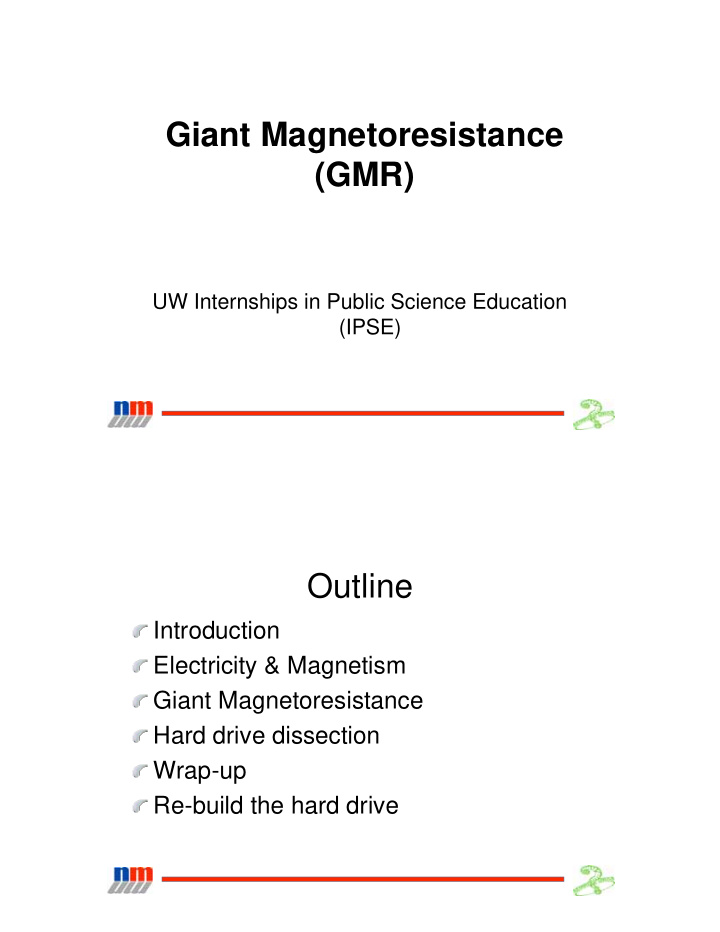



Giant Magnetoresistance (GMR) UW Internships in Public Science Education (IPSE) Outline Introduction Electricity & Magnetism Giant Magnetoresistance Hard drive dissection Wrap-up Re-build the hard drive
Giant Magneto Resistance (GMR) Layers on “nano” level Store info on computer hard drive Electricity Diagram of an atom ELECTRONS (e - ) NUCLEUS
Electricity (cont’d) Electric Current � Moving free electrons negative e - e - Wire e - e - positive Note: Electrons are actually much smaller in relation to the wire than shown in the picture. Electricity (cont’d) Conductor Low resistance Allows movement of large amounts of free electrons Insulator High resistance Allows very little free electrons to move
Electricity (cont’d) Diagram of Simple Circuit LED 1. Insert test material to complete the circuit. - + 2. Determine if test BATTERY material is a TEST conductor or MATERIAL an insulator . HINT : Look at how the LED reacts with the test material. Question Time! Which materials are good conductors of electricity? Why? Are there any that don’t conduct electricity at all? Why? Which type of materials (conductors or insulators) have a high resistance to electricity?
Magnetism One more thing about electrons….. They Spin!!! downspin upspin Magnetism (cont’d) Non-magnetic material Electron spins are opposite and balance each other out. Magnetic material Electron spins are unequal, with the majority spinning in one direction.
Magnetism (cont’d) Magnetic material attracts to magnet. Test MAGNET Material Non-magnetic material is not affected by magnet. Test MAGNET Material Question Time! Which materials are magnetic? Why?
Electricity/Magnetism Relationship A changing magnetic field creates an electric current. Coils MAGNET Current Question Time! Can you create an electric current with the copper coil and cow magnet? How do you know that you created an electric current?
What does electricity and magnetism have to do with GMR?!?! Magnetoresistance is used to store 1. information onto a computer’s hard disk drive (like the last demonstration!) but not very sensitive. GMR is more sensitive and allows more 2. data to be stored. GMR materials are found on Read/Write 3. Heads and detect small changes in electrical resistance. Giant Magnetoresistance GMR materials Electrons Electrons MAGNET MAGNET NON-MAGNET NON-MAGNET MAGNET MAGNET MAGNET NON-MAGNET NON-MAGNET MAGNET MAGNET HIGH LOW RESISTANCE RESISTANCE
Read/Write Head http://www.howstuffworks.com/hard-disk2.htm http://www.pcguide.com/ref/hdd/op/heads/op.htm GMR (cont’d) How data is stored on a hard disk Note: Domains are actually much smaller than this picture indicates.
Question Time! Explain two ways in which electricity and/or magnetism are related to GMR. Find GMR Materials! Obtain a hard drive and a screwdriver Remove screws and place into cup Locate the read/write head in the hard drive (HINT: This is where you can find GMR materials!)
Read/Write Head http://www.howstuffworks.com/hard-disk2.htm http://www.pcguide.com/ref/hdd/op/heads/op.htm Applications of GMR Sensors Portable Traffic Counters http://www.mega-technical.com/ html/prod-histar.html Mountain bike “Smart GMR Shocks” sensor Magnetization Recording medium *Image from IBM Almaden
Questions?
Recommend
More recommend